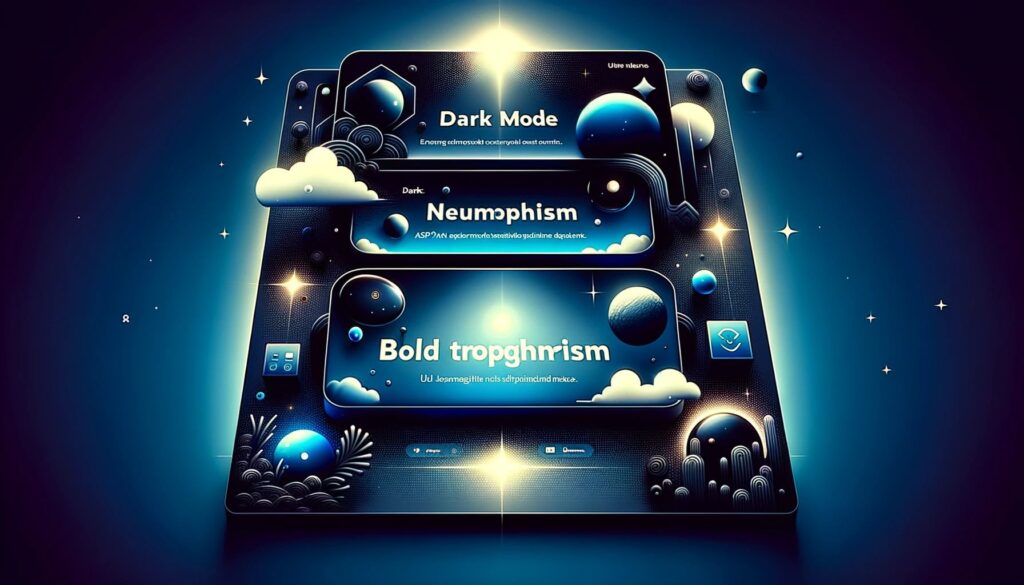Introduction to Modern UI/UX Design in ASP.NET
In the ever-evolving realm of web development, the significance of User Interface (UI) and User Experience (UX) design has skyrocketed. Modern UI/UX design is not just about aesthetics; it’s about creating intuitive, user-friendly interfaces that enhance the overall experience of web applications. ASP.NET, a prominent web development framework by Microsoft, offers a robust platform for implementing cutting-edge UI/UX designs.
The Role of UI/UX in Web Development
The importance of UI/UX design in web development cannot be overstated. A well-designed UI ensures that users find it easy and enjoyable to interact with a website or application, leading to increased engagement and satisfaction. On the other hand, UX design focuses on the overall feel of the experience, ensuring that users find the interface intuitive and their interactions meaningful.
The Evolution of ASP.NET in UI/UX Design
ASP.NET has evolved significantly over the years, offering developers a plethora of tools and frameworks to create dynamic and responsive UI/UX designs. The integration of modern design trends and technologies has made ASP.NET a go-to choice for developing sophisticated web applications.
Emerging UI Trends in ASP.NET
The user interface (UI) in ASP.NET is rapidly evolving, embracing new design trends that enhance both aesthetics and functionality. Staying ahead in UI design means understanding and implementing these emerging trends.

Dark Mode
Dark mode, a design choice offering a dark color scheme, reduces eye strain in low-light conditions and saves energy on devices with OLED or AMOLED screens. In ASP.NET, implementing dark mode can be achieved through CSS media queries or theme switchers, offering users a choice between light and dark themes.
Neumorphism
Neumorphism (or New Skeuomorphism) is a design trend that combines background colors, shapes, gradients, and shadows to mimic physicality in digital interfaces. In ASP.NET, this can be implemented using CSS styles to create soft, extruding elements that provide a tactile feel to UI elements.
Bold Typography
Bold typography is a trend that focuses on delivering messages clearly and emphatically. In ASP.NET applications, bold fonts can be used to create impactful headings and draw attention to key sections. Combining different font weights and sizes can create a visual hierarchy, guiding users through the content effectively.
The Rise of 3D Elements
3D elements in UI design add depth and realism. In ASP.NET, 3D models can be integrated using libraries like Babylon.js or Three.js. This trend is particularly relevant in e-commerce and product showcases, where 3D models offer a more immersive experience.
UX Innovations: AI and Personalization in ASP.NET
The landscape of User Experience (UX) in ASP.NET is being transformed by the integration of Artificial Intelligence (AI) and personalization techniques. These innovations are not just reshaping the way users interact with applications, but also how developers approach UX design.
AI-Integrated Design
AI in UX design brings a new level of intelligence and automation. In ASP.NET, AI can be employed for various purposes:
- Automated User Experience Analysis: Tools powered by AI can analyze user interactions and provide insights on improving the UX.
- Personalized User Experiences: AI algorithms can tailor content and functionality to individual users, enhancing engagement and satisfaction.
- Chatbots and Virtual Assistants: Integrating AI-driven chatbots or virtual assistants, such as ChatGPT, can offer real-time assistance and improve user engagement.
Personalization Trends
Personalization in UX design is about delivering user-specific content and experiences. In ASP.NET, this can be achieved through:
- User Behavior Tracking: Understanding user behaviors and preferences through analytics.
- Dynamic Content Delivery: Customizing content based on user profiles and past interactions.
- Adaptive Interfaces: Designing interfaces that adapt to user preferences and habits over time.
ASP.NET Core Blazor: A Game Changer in UI/UX
ASP.NET Core Blazor is redefining modern web UI development with its comprehensive features that cater to rich, interactive UI designs. Blazor, as a full-stack web UI framework, is particularly recommended for a wide range of web UI scenarios in ASP.NET.
Key Benefits of Using Blazor for UI/UX Design
- Reusable Component Model: Blazor enables developers to create modular and reusable UI components, enhancing the efficiency of the development process.
- Efficient Rendering: It employs a diff-based component rendering approach, ensuring optimal performance by updating only the necessary parts of the UI.
- Flexibility in Rendering: Blazor components can be rendered from the server or client-side using WebAssembly, offering flexibility in how applications are deployed and run.
- Rich Interactive Web UI Components: Developers can build sophisticated UI components using C#, which can interact seamlessly with JavaScript when necessary.
- Progressive Enhancement: Blazor allows for progressive enhancement of server-rendered components. This means smoother navigation, better form handling, and the ability to enable streaming rendering.
- Shared Logic Across Client and Server: A significant advantage is the ability to share code and business logic between the client and server sides, reducing redundancy and streamlining development.
- Integration with Existing Apps: Blazor can be integrated with existing MVC, Razor Pages, or JavaScript-based applications, providing a versatile solution for upgrading UI/UX without complete overhauls.
Leveraging ASP.NET Core Razor Pages for Enhanced UX
ASP.NET Core Razor Pages is emerging as a powerful tool for building server-rendered UIs that are both dynamic and efficient. This page-based model is particularly suited for applications where seamless user experiences are paramount.
Advantages of Using Razor Pages in UI/UX Design
- Simplicity and Efficiency: Razor Pages make it easy to build and update UIs. Code for the page is kept with the page, simplifying organization and maintaining a clear separation of UI and business logic.
- Enhanced Organization: ASP.NET Core Razor Pages offer a more straightforward way to organize web applications compared to traditional MVC. View-specific logic and view models are grouped together, allowing for cleaner and more maintainable codebases.
- Testability and Scalability: These pages are highly testable and scale well for large applications, ensuring that as your project grows, the UI/UX remains consistent and manageable.
- Dynamic Rendering: Razor Pages dynamically render HTML and CSS on the server in response to browser requests, ensuring that the page arrives at the client fully ready for display. This server-side rendering is key to fast load times and improved performance.
- Seamless Integration with ASP.NET Core MVC: Razor Pages are built on ASP.NET Core MVC, offering seamless integration and the ability to leverage MVC’s powerful features in a page-based context.
Model-View-Controller (MVC) Pattern in ASP.NET Core
ASP.NET Core MVC, employing the Model-View-Controller architectural pattern, is a cornerstone for building scalable and maintainable web applications. This pattern’s separation of concerns not only facilitates more organized coding but also enhances UI/UX design.
Benefits of ASP.NET Core MVC in UI/UX
- Scalable Architecture: MVC provides a robust framework for building large web applications, making it easier to manage and scale UI/UX design as the application grows.
- Clear Separation of Concerns: The MVC pattern distinctly separates models, views, and controllers. This separation ensures that UI/UX design elements (views) can evolve independently from the business logic (models) and application control (controllers).
- Enhanced Flexibility: This separation allows for more flexible design and development, as changes to the UI can be made without affecting the underlying business logic.
- Improved Testability: MVC architecture makes it easier to test different components of the application independently, ensuring a more reliable and consistent user experience.
- Streamlined Development Process: By structuring the application into logical components, MVC facilitates a more streamlined and efficient development process, allowing teams to focus on specific aspects of the application, including UI/UX design.
Single Page Applications (SPA) with JavaScript Frameworks in ASP.NET Core
ASP.NET Core’s support for Single Page Applications (SPAs) using JavaScript frameworks marks a significant shift in building interactive and responsive UIs. These SPAs offer a seamless user experience, mimicking the feel of a desktop application in a web browser.
Integrating JavaScript Frameworks with ASP.NET Core
- Utilizing Popular Frameworks: ASP.NET Core provides templates for popular JavaScript frameworks like Angular, React, and Vue. This integration allows for building client-side logic that’s both dynamic and responsive.
- Benefits of ASP.NET Core SPA:
- Improved User Experience: SPAs provide a smooth, app-like user experience with fast transitions and responsive interactions.
- Large Community Support: With a vast ecosystem of libraries and resources, developers have access to a wide range of tools and community support.
- Efficient Client-Side Rendering: The JavaScript runtime environment in the browser enables efficient client-side rendering, reducing server load and improving performance.
- Challenges and Considerations:
- Complexity: Implementing SPAs requires familiarity with additional languages, frameworks, and tools.
- Code Duplication: Sharing logic between client and server can be challenging, leading to potential code duplication.
Choose a Hybrid Solution: ASP.NET Core MVC or Razor Pages plus Blazor
Combining ASP.NET Core MVC or Razor Pages with Blazor presents a powerful hybrid approach for UI/UX design. This integration leverages the strengths of each framework, offering a flexible and efficient solution for modern web applications.
Advantages of Hybrid Approach in UI/UX
- Enhanced Performance: The hybrid model allows for prerendering components on the server, which improves the perceived load time of the app.
- Interactivity and Usability: Adding Blazor components to MVC or Razor Pages enhances interactivity without sacrificing the server-side rendering benefits, offering a richer user experience.
- Seamless Integration: Blazor components can be easily integrated into existing Razor Pages and MVC apps, enabling developers to enhance UI/UX without complete overhauls.
- Versatility and Flexibility: This approach provides the flexibility to choose the most suitable technology for each aspect of the application, be it client-side interactivity with Blazor or robust server-side rendering with MVC or Razor Pages.
- Maintainability and Scalability: A hybrid solution makes it easier to maintain and scale the application, as each part of the app can be developed and updated independently.
Conclusion
In conclusion, modern UI/UX design in ASP.NET has traversed an evolutionary path, embracing innovative trends and technologies to enhance user interaction and satisfaction. From the adaptive darkness of Dark Mode to the intelligent personalization powered by AI, ASP.NET’s ecosystem offers a rich palette of tools and frameworks like Blazor, Razor Pages, and MVC. These tools not only cater to aesthetic needs but also ensure functional, efficient, and interactive web applications. The integration of JavaScript frameworks in SPAs and the strategic use of hybrid models combining MVC, Razor Pages, and Blazor underscore ASP.NET’s commitment to versatile, scalable, and user-centric design approaches.
As we look to the future, the landscape of UI/UX design in ASP.NET is poised for further innovation. The continuous integration of emerging technologies and design philosophies promises to elevate the user experience to new heights. Developers and designers leveraging ASP.NET are equipped to craft intuitive, engaging, and responsive applications. In this dynamic digital era, ASP.NET stands as a pivotal framework, shaping the way we interact with web applications and setting new benchmarks in UI/UX design excellence.




